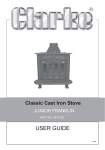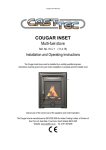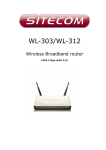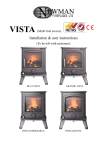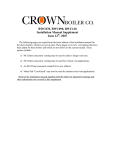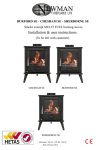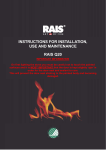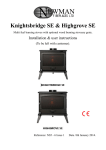Download Clarke JUNIOR FRANKLIN User guide
Transcript
Classic Cast Iron Stove JUNIOR FRANKLIN PART NO: 6910120 USER GUIDE GC0909 INTRODUCTION Thank you for purchasing this CLARKE Classic Cast Iron Stove. Before attempting to instal or use the stove, please read this manual thoughout and follow the instructions carefully. Thoroughly familiarise yourself with this stove & it’s operation in order to ensure the safety of yourself and others around you. Henceforth, you can look forward to the stove giving you long and satisfactory service. GUARANTEE This product is guaranteed against faulty manufacture for a period of 12 months from the date of purchase. Please keep your receipt which will be required as proof of purchase. This guarantee is invalid if the product is found to have been abused or tampered with in any way, or not used for the purpose for which it was intended. Faulty goods should be returned to their place of purchase, no product can be returned to us without prior permission. This guarantee does not effect your statutory rights. SPECIFICATION JUNIOR FRANKLIN Part Number 6910120 Weight 102 kg Dimensions (w x h x l) 755 x 658 x 540 mm Flue Size 170 mm o/d Max BTU Output 54,000 Efficiency 78% @ 9 kw Fuel Multi fuel Nominal Heat Output 10 kw Class 1 Operation Intermittent Please note that the details and specifications contained herein, are correct at the time of going to print. However, CLARKE International reserve the right to change specifications at any time without prior notice. 2 GENERAL SAFETY RULES WARNING: Do not use in mobile homes. This stove must be connected to a suitable flue outlet. Due to high temperature this stove should be located well away from furniture and curtains. Children and adults should be alerted to the hazards of hot surfaces. Young children should be carefully supervised when they are in the same room with the stove. Do not place clothing or other flammable material on or near the stove. Keep the stove area clear of combustible materials, flammable liquids or vapours. 1. ALWAYS read and understand the manual before installing and commissioning the fire. 2. ALWAYS ensure the stove is installed in accordance with local regulations. 3. ALWAYS ensure that the stove is correctly installed and positioned as described under POSITIONING AND INSTALLATION on page 5, and that the immediate area is kept clear. 4. ALWAYS check for damage before using the stove. Check for breakage of parts and any other condition that may affect the stoves performance. Any damage should be properly repaired or the part replaced. If in doubt, DO NOT use the stove. Consult your local dealer. 5. ALWAYS keep children and visitors at a safe distance from the stove. 6. NEVER direct water, or any other liquid on to the stove, particularly when it is hot. 7. NEVER use gasolene or other flammable liquids for fire starting. 8. NEVER use the stove to incinerate materials other than the recommended fuels. 9. The installation of the stove and chimney MUST comply with all national, European and local building regulations. It is the responsibility of the owner and the installer to ensure that the installation complies. 10. NEVER carry out any modifications to this product. If experiencing difficulty of any kind consult your local dealer. UNPACKING & ASSEMBLY Before assembling, please check contents against the following list and advise your dealer immediately if any parts are missing. 1 x Stove body 4 x Legs 1 x Fixings Kit 1 x Flue Connection c/w Fireproof Gasket 1 x Flue Adaptor 1 x Baffle Plate 1 x Ash-pan & Handle 1 x Grate 1 x Flue Blanking Blate 3 TOOLS REQUIRED Phillips screwdriver 13mm spanner WARNING: DUE TO THE WEIGHT OF THE STOVE IT IS RECOMMENDED THAT TWO PEOPLE PERFORM THE UNPACKING AND ASSEMBLY. Unpack the stove and remove packing materials. Open the doors and remove the grate, ashpan, legs, Flue with flue adaptor and fixings kit from inside the stove. 1. Place the stove on a soft surface such as the polystyrene packing materials from the crate and tilt the stove back. 2. Attach the legs using the bolts and large washers supplied as shown in Fig 1. 3. Sit the stove upright and attach the flue adaptor as shown in Fig 2 using the screws supplied. Ensure the fireproof gasket is correctly seated in the base of the flue adaptor. 4. Check that the blanking plate is installed in the rear panel of the stove when the normal flue exit is required. • If the rear mounting flue configuration is to be used, the blanking plate will be fitted to the top of the stove and the flue connector to the rear panel. 5. Set the grate and ashpan in position as in Fig 3. A handle is supplied for when the stove is in use. 5. Place stove in the desired location as shown in POSITIONING AND INSTALLATION. Take care not to damage the floor surface. Note; All stoves must be installed in accordance with the local building regulations. Fig 3 4 POSITIONING & INSTALLATION All local regulations, including those referring to national and European Standards need to be complied with when installing this appliance. WARNING: IF THIS STOVE IS NOT PROPERLY INSTALLED, A HOUSE FIRE MAY RESULT. FOR YOUR SAFETY, CONTACT THE LOCAL BUILDING OR FIRE OFFICIALS ABOUT RESTRICTIONS AND INSTALLATION REQUIREMENTS IN YOUR AREA. POSITIONING The stove must only be installed on floors with an adequate load bearing capacity and if the existing construction is not suitable, aditional measures such as a load distributing plate must be provided. The stove should only be placed on a wooden floor if it has been covered by a protective metal plate at least 5mm thick or other non-flammable floor protector such as 20mm ceraform board or other non-combustable material having a conductivity of K=0.84 BTU/FT2 HR-IN-degF. Combustable materials such as carpet or linoleum must be removed from beneath the stove. When the stove is positioned near a wall constructed of flammable material, the distances shown on Fig 4 must be adhered to. Alternatively, a heat shield may be used, mounted according to the position of the fireplace. A firewall must be at least 100 mm thick and typically made of brick, or concrete/ stone. It is recommended that the stove be installed 800 mm from furniture and serious consideration should be given to the positioning of any furniture that could be adversely affected by heat. The clearance to any combustable materials should also be a minimum of 800mm. Fig 4 5 The stove must have a minimum clearance of 1200 mm to a combustable ceiling above. Due to the heat of a hot stove, a suitable fire guard should be used to provide additional protection. Note; All stoves should be installed in accordance with the local building regulations. THE CHIMNEY The stove is supplied with a flue pipe for top mounting with the fixing screws supplied. The stove should never be connected to a shared chimney/flue system. When sections of the flue pipe fit into one another, the end facing upwards must be the end with the larger internal dimensions with the downward facing pipe fitting into it such that deposits do not collect on the joint or allow condensation to weep at the joints. Flue pipes with a smaller cross-sectional area than that of the stove outlet should never be used. Flue pipes must not project into the chimney connector, such as to cause a restriction to the gas flow. Ensure the joints are completely sealed as air leakage will lead to poor performance. Avoid having more than two bends in the flue system. Any offset between bends should be minimised and the flue should be equipped with suitable access doors for inspection & cleaning. A range of suitable flue pipes, cowls and fire cement are available from your Clarke dealer. Special methods are required when passing through a wall or ceiling. Please refer to your local building regulations and/or fire department. Assuming that when the stove is first installed, the chimney is clean, and sound, then the chimney & flue should be inspected part way through the burning season to establish the regularity of sweeping required. This should always be less than one year. Fig 5 6 USING YOUR STOVE CONTROLS The amount of heat emitted by the stove is regulated using two air controls. A) The primary air supply is controlled using the two lower air controls built into the doors. B) A second air inlet provides a constant, pre-heated air supply to the combustion just above the fire. This is controlled using the upper air controls mounted at the top of the doors. This air supply will not normally need to be regulated so will usually be kept open. Fig 6 FIRST USE Following installation, and before regular use, the stove must be seasoned to prevent cracking of the metal castings. This procedure should also be followed if the stove has not been used for prolonged periods (during the summer months for example), and is carried out as follows: 1. Light a small fire in the middle of the stove, well away from the sides. 2. Allow the stove to warm up slowly and evenly with the air controls almost closed, avoiding intense flames. 3. Keep the fire burning for three hours or so, gradually increasing the size of the fire using larger logs which will burn naturally but slowly, keeping the stove on a low setting. 4. After a couple of days burning at this level, increase the brightness & intensity of the fire gradually over the next 10 days. Full strength fires should not be used until completion of approx 20 days of mild use. Only from this time will the stove have been properly seasoned. It should be remembered that this procedure should be carried out at the beginning of each season of use in order to remove the moisture retained by the metal during the period of non-use. When used for the first time the fireplace may smell a little, due to gas being given off. The gas is not toxic but the room should be thoroughly ventilated. Let the fire burn with a high draught until no smells can be detected. 7 Take care not to open the stove doors too vigorously in case of causing smoke spillage. If smoke spillage occurs when the fire doors are opened this could be due to poor chimney draft. SEE TROUBLESHOOTING. FIRE-LIGHTING WITH WOOD 1. Open the air controls. 2. Lay firelighters or rolled up newspapers on the grate with a reasonable quantity of dry kindling wood. Place 2 or 3 small logs on top. 3. Light the newspaper or firelighters using a long taper and close the doors. 4. When the fire is burning strongly, add further logs up to 10mm diameter. 5. When the stove is really hot, close the air controls as required. 6. The burn rate can be reduced by partially closing the air controls. Ensure there are lasting flames until the wood becomes charcoal. FIRE-LIGHTING WITH SOLID FUEL 1. Open the air controls. 2. Lay firelighters or rolled up newspapers in the stove with a reasonable quantity of dry kindling wood. Place a small quantity of solid fuel on top. 3. Light the newspaper or firelighters using a long taper and close the doors. 4. When the fire is burning strongly, add further fuel. 5. When the stove is hot, close the top air controls. 6. The burn rate can be reduced by partially closing the lower air controls. REFUELLING 1. Open the doors and add fuel. Always open the doors slowly to avoid a sudden rush of intake air and smoke escaping into the room. 2. Open the air controls and leave open for a few minutes to allow the gasses in the wood to burn before closing. 3. Ensure the doors are kept closed to contain fumes except when lighting up, refuelling or removing ash. • The rate of refuelling and heat available are dependant upon individual requirements based upon the user’s experience. When reloading, it is normally necessary to burn the stove fast initially, to drive off any gasses and moisture before closing the air vents to control the burn rate. • Overnight burning is achieved by driving off any gasses or moisture as before, following a full charge of fuel and then closing the air vents fully. Experience will indicate the optimum setting. • It is not recommended to leave the stove alight at night or to continue using the stove in mild weather which gives poor combustion leading to a greater buildup of soot. 8 A mixture of fuels can be used in conjunction with wood, provided the base of the fire remains as wood or compressed block fuels, with coal products being added to this with the volume of coal products being less than that of other fuels. With solid fuels, there is less need to burn the stove hard after refuelling. The rate of refuelling will also be less often than with wood. WARNING: OVER-FIRING THE STOVE MAY CAUSE A HOUSE FIRE. IF THE CHIMNEY IS SEEN TO BE GLOWING THE STOVE IS OVER-FIRED. TYPES OF FUEL This stove will function with all kinds of either solid fuel or wood but in general all fuel should be dry and timber should be well seasoned so as to have a moisture content below 20%. The use of damp wood will result in more soot and deposits being left in the chimney, flu and stove and will not release heat if thermal energy is being used to drive out moisture from the fuel. Avoid using the stove to incinerate other materials including household waste. Avoid using ‘green’ unseasoned wood, treated wood such as telegraph poles, or plywood or chipboard containing glues and resins which pollute the environment and cause the fire to burn too quickly. Such materials can produce excessive tar or creosote which can be damaging and in extreme cases cause a fire inside the chimney. The dryness of wood can be assessed by looking at the end of the log. Radial cracks, deep enough to be considered as splits should be present in dry, seasoned logs. This level of dryness may take up to two years to achieve. The maximum length of fuel suitable for this stove is approx 26 cm so as to lay flat over the embers. Logs of greater than 10cm diameter should be split. Suitable solid fuels may include smokeless fuels such as Phurnacite, Coalite Nuts or Extracite. Confirm with your fuel provider as to which type will suit best. Larger fuels will allow a greater draught in the firebox which will speed up combustion. Household coal is not well suited as it produces excessive ash and chimney deposits. ASH REMOVAL Keep the stove free from a heavy buildup of ash. The frequency of this is dependant upon the type and quality of fuel being used. Ash should be removed before it builds up to the underside of the grate, at which point, the grate would be burning hot on both sides, shortening its life expectancy. When disposing of ashes, ensure they have cooled and always place in a metal container. Be sure to remove the ash when the fire is at its lowest point such as first thing in the morning. 9 MAINTENANCE The stove and flueway should be inspected and maintained when in a cold condition. CHIMNEY SWEEPING Inspect the flue and chimney for a buildup of deposits especially following prolonged periods without use. The entire chinmey/flue should be swept frequently from top to bottom by a registered chimney sweep to remove any buildup of soot etc, the frequency being dependant upon the usage and the fuels being burnt. If the chimney is swept after a few weeks of regular use, the condition found will give an indication of the frequency required. On an annual basis, the chimney is best swept just before the main winter burning season. CLEANING The inside of the stove may require regular cleaning, especially during periods of peak use, the frequency of this being indicated by experience. It is advisable to wear a dust mask, protective gloves and safety glasses when cleaning. Use a stiff brush and industrial type vacuum cleaner to dislodge and remove as much material as possible, starting at the top of the stove and working down to the bottom. Particular attention should be given to the air inlet controls which can become obstructed. GENERAL MAINTENANCE Take this opertunity to check for any damaged parts inside the stove. In the event of damage or broken components, replacements can be obtained from your Clarke dealer. Unauthorised spare parts should on no account be used. Inspect the fireproof door seals where fitted, to ensure there is an effective seal around the door and re-fix it if loose using stove rope adhesive. If in poor condition it should be replaced. If the stove is purely ornamental, painting will provide a durable, attractive finish. If the stove is used for heating and cooking, a high temperature heat resistant paint must be used, in either aerosol or brush applied form. Should rust become apparent, clean thoroughly with a wire brush and apply a suitable anti-rust treatment. The window glass should remain clean during normal use but it can become blackened if the stove is being operated with either damp fuels or at a slowburn rate. The blackening may be dispersed by burning briefly at a much higher temperature, or it may be cleaned off using specialist glass cleaner. 10 In the event of the glass being broken, it can be removed by unscrewing the retaining clips, taking care not to damage the fireproof seal. The replacement glass should be carefully placed against the seal and the retaining clips re-tensioned. Take care to tension these evenly or there is a risk of breaking the new glass pane. During prolonged periods out of use, the air inlets should be left open and the door left slightly ajar in order to circulate fresh air and discourage condensation from forming which could encourage corrosion. If disposing of this product, do not dispose of with general waste. Metal products should be taken to your local civic amenity site for recycling of metal products. 11 TROUBLESHOOTING PROBLEM CAUSE SOLUTION Fire difficult to start. Wood green, too damp or poor quality. Use recommended fuel. Logs are too big. When lighting the fire use small, dry twigs. To maintain the fire use split logs. Air starvation. Open upper and lower air controls. Insufficient draught. Check that flue is not obstructed, sweep flue if necessary. Too much draught. Ensure that the lower air control is closed. Partially close the top air control. Excessive draw. Install a draught stabiliser. Consult your dealer. Poor quality wood. Do not continuously burn small wood, sticks, carpentry offcuts, plywood etc. Flue duct is cold. Burn paper and kindling wood to increase heat. Room is at negative air pressure to the outside. In houses equipped with mechanical ventilation, open a window until the fire is well established. Low heat output. Incorrect fuels. Use recommended fuels. Smokes while burning. Draught is insufficient. Consult a chimney specialist. Check that flue is not obstructed. Sweep if necessary. Downdraught. Install an anti-downdraught cowl. Consult your dealer. Room is at negative pressure to outside. In houses equipped with mechanical ventilation, an outside air intake must be installed in the chimney. Chimney not tall enough to be clear of roof line. Increase height of chimney. Poor sealing of flue-pipe joints. Re-connect flue or replace jointing material. Flue is partially blocked with soot. Arrange to have chimney swept. House too tightly sealed. Ensure a fresh air supply is reaching the stove. Fire goes out. Fire burns too quickly. Stove smokes when lighting up. Smoke spillage when opening door. 12 PARTS DIAGRAM IMPORTANT: The use of parts other than CLARKE replacement parts may result in safety hazards, decreased appliance performance and may invalidate your warranty. 13 COMPONENT PARTS LIST No Description No Description 1 Bottom Plate 14 Control Knob 2 Base Plate 15 Lefthand Door 3 Back Plate 16 Righthand Door 4 Rear Firebrick 17 Fireproof Gasket 5 Left Side Plate 18 Window Glass 6 Right Sideplate 19 Primary Air Control 7 Front Plate 20 Control Knob 8 Top Plate 21 Leg 9 Grate 22 Flue Base 10 Left Firebrick Panel 23 Door Handle 11 Right Firebrick Panel 24 Upper Flue (not shown) 12 Baffle Assembly 25 Blanking Plate 13 Secondary Air Control 14 NOTES __________________________________________________________________________ __________________________________________________________________________ __________________________________________________________________________ __________________________________________________________________________ __________________________________________________________________________ __________________________________________________________________________ __________________________________________________________________________ __________________________________________________________________________ __________________________________________________________________________ __________________________________________________________________________ __________________________________________________________________________ __________________________________________________________________________ __________________________________________________________________________ __________________________________________________________________________ __________________________________________________________________________ 15
















